Their story has the American dream written all over it. Late one night in 2007, Brian Case and Lee Conn, motorcycle buddies turned business partners, were chatting over drinks when the conversation turned to their ideal motorcycle. “We did the napkin sketch method and asked ourselves—’what would be the coolest motorcycle?’” Conn says.
What ended up on that napkin had all the makings for a sport-touring motorcycle—something the duo wasn’t expecting. In fact, they didn’t know what to expect. Both are diehard motorcycle enthusiasts who have owned everything from sportbikes to cruisers, import and domestic, but realized their ideal motorcycle didn’t exist yet. Motorcycle.com had a chance to speak with Conn and get an in-depth look at the men, the motivation and ultimately, the machine that is the Motus MST.
“We didn’t want to twist ourselves up like a pretzel anymore,” Conn said when describing the sketch on the napkin, “but we still wanted to be able to ride all day.” He explained that their ideal bike would be one that could do everything from shred miles to carve canyons, two-up or solo. When they realized that their ideal motorcycle was a sport-tourer, it dawned on them that nothing was available to them that’s made right here in the good ‘ol US of A.
And that’s when the idea struck them. Armed with nothing more than their entrepreneurial spirit, a background in aircraft manufacturing (Conn) and product development (Case, who co-designed the Confederate Wraith), the duo set out to design “the ultimate, modern American street bike,” and thus Motus was born.
Pure Americana
Naturally when designing a new motorcycle, the first question centers around the powerplant. “When it came to the engine we went to one place: Motor City.” While they met with multiple potential partners, Conn and Case knew they struck gold with Katech Inc., the same outfit that prepares the engines for General Motors’ racing program. Conn and Case had some specific parameters they wanted met in regards to the engine. Chief among them was sacrificing outright horsepower in the name of a broad spread of torque.
When it comes to torque, V-engine configurations are renowned for just that. But the two upstarts weren’t satisfied with any of the current offerings from other manufacturers, and here again their desire to be uniquely American came to the forefront. They decided to build their own engine, and this is where Katech’s expertise came in handy. The solution is a 1645cc (100ci), liquid-cooled, V4 (internally dubbed the KMV4) that’s basically a LS7 V8 (the same engine in the Corvette) cut in half. Rest assured, the engine design is all original and is only a derivative of the Chevy mill.
Some elements of the classic American V8 remain, however. Its overhead valves are met with pushrods, which are metered through a chain-driven camshaft. Hydraulic lifters keep maintenance simple. Bore and stroke measure 86.5mm x 70.0mm and compression ratio is set at 11.5:1. Why the low-tech engine in a world of dual overhead cams? “Modern engines are so complex now that riders can’t understand them,” Conn says, “Our engine allows the shadetree mechanic to feel confident they can fix anything that isn’t right.”
That doesn’t mean that the KMV4 is completely low-tech. The implementation of gasoline direct injection brings the mill into the 21st century, a first for a (potentially) production motorcycle. As the name implies, GDI digitally injects highly atomized fuel directly into the cylinders (much like diesel engines) as opposed to injectors spraying fuel into the intake ports, as seen on virtually every other fuel-injected motorcycle. That engine is mated to Motus’ own proprietary six-speed transmission, with chain drive, geared to ensure the KMV4 spins as slowly as possible at cruising speeds for optimum fuel mileage. Power claims hover around the 160 horsepower mark at the crank, with torque expected around 120 ft.-lbs.
The Motown connection doesn’t end there. When it came to chassis development, the dynamic duo of Conn and Case formed a partnership with another well-respected name in motorsports: Pratt & Miller. Known for their numerous auto racing accomplishments including championships in the Rolex Grand-Am series, NASCAR and six Le Mans 24-hour victories, Motus were naturally drawn to their chassis expertise, despite their lack of two-wheeled credentials.
With a specific set of parameters in mind, the team took its time utilizing finite element analysis and rapid prototyping processes to determine a tubular chromoly trellis frame would be the best option to achieve the rigidity desired, yet maintain a certain amount of flex to give the rider a feel for the road. “We spent eight months developing the chassis before ever cutting a piece of metal,” Case said. The KMV4 engine is mounted longitudinally in the frame and acts as a stressed member, giving it a Moto-Guzzi-esque appearance.
Seeing as how both Guzzis and now the Motus feature longitudinally-mounted Vees, we felt the need to reference the MST against the Moto-Guzzi Norge, two uniquely similar machines. For starters, both have almost identical wheelbases, with the Norge one inch longer at 59.0 inches. Seat height is the same at 31.0 inches, though the MST has slightly more rake angle at 26.0 degrees compared to 25.3 on the Norge. That should give the Italian machine a slight edge in agility, though the half-inch less trail for the MST (4.25 inches vs. 4.72 inches for the Norge) will ultimately give it a slightly different handling characteristic.
Speaking of handling, the MST will come equipped with 43mm inverted forks that are fully adjustable. Fork supplier for the standard MST is yet to be determined, but the higher-spec MST-R model is expected to wear Ohlins suspension front and rear. The standard rear shock supplier is also yet to be finalized, but expect full adjustability.
Stopping power comes from dual 320mm floating rotors up front, clamped by four-piston, radially mounted calipers. As of press time, Hayes will provide the calipers for the standard model; expect Brembo units for the R model. A standard two-pot caliper handles rear braking duties. This is all transferred to the ground via Michelin Pilot Road 3 tires on 17x3.5-inch front, 17x6.0-inch rear wheels. All told, the MST is predicted to weight 500 pounds, dry—about on-par with similar sport-touring rigs.
The Future Ahead
The MST looks like it has the ingredients to challenge for top sport-touring honors against some of the most respected names in the industry. From the onset, Conn and Case centered the design and execution of the MST around three premises: performance, comfort, and range. They wanted a motorcycle with sportbike-like performance that wouldn’t require chiropractic assistance afterwards, and fuel economy that limits the number of gas stops. With the KMV4 engine, more upright ergos, and a six-gallon tank, they believe they’ve accomplished just that.
So who does the MST appeal to? “We think it will draw two types of riders,” Conn said, after admitting to being both types. There’s the sportbike rider who is getting older and can’t bend like a gymnast anymore, but still wants performance and range, and then there’s the cruiser rider who can relate to the V4 engine because “it looks like the one in my truck.”
After speaking with Conn at length, it’s clear he and Case have poured their heart and soul into this project, but the glaring question remains: Why now? Especially in these economic times?
“We don’t think there’s a better time,” Conn explained, with a clear sense of patriotism in his voice. “If [the American] people don’t get off their ass there won’t be any manufacturing left in this country.”
We are witnessing the opening chapters in the Motus story. There are still long roads ahead, especially since a true production version is yet to be made. Numerous testing miles need to be logged to make sure all the components meet certain standards. At the conclusion of the weekend’s racing and festivities in Daytona, Conn and Case are personally going to ride the two existing prototypes across the country, meeting with potential dealers, media and the public, to put the bikes to the test. They’ll be followed the entire way by a team of engineers from Pratt & Miller to chart the progress and remedy any possible mishaps.
“The plan is to ride them until they break, fix it, and ride it ‘till they break again. By that point, they’ll stop breaking.”
Tentatively speaking, the MST and MST-R are slated for production in late 2011 as 2012 models, but certain things like securing suppliers and, more importantly, passing quality control tests, can push back that date.
“We only have one chance to get this right. We’re not going to cut corners and screw it up. If that means delaying production, so be it.”
Pricing is yet to be determined, but as it’s a niche bike built in small volumes, expect a price tag that reflects that. Then again, volume will depend on the number of dealers interested, and that in turn could help lower costs.
One thing’s for sure: Lee Conn and Brian Case are determined to turn Motus into another example of the American dream.
What ended up on that napkin had all the makings for a sport-touring motorcycle—something the duo wasn’t expecting. In fact, they didn’t know what to expect. Both are diehard motorcycle enthusiasts who have owned everything from sportbikes to cruisers, import and domestic, but realized their ideal motorcycle didn’t exist yet. Motorcycle.com had a chance to speak with Conn and get an in-depth look at the men, the motivation and ultimately, the machine that is the Motus MST.
“We didn’t want to twist ourselves up like a pretzel anymore,” Conn said when describing the sketch on the napkin, “but we still wanted to be able to ride all day.” He explained that their ideal bike would be one that could do everything from shred miles to carve canyons, two-up or solo. When they realized that their ideal motorcycle was a sport-tourer, it dawned on them that nothing was available to them that’s made right here in the good ‘ol US of A.
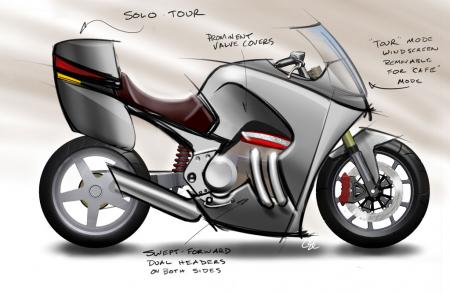 We’re sure this isn’t the original napkin sketch Conn and Case drew up during their first meeting, but here is the concept for their ideal motorcycle. We’re sure this isn’t the original napkin sketch Conn and Case drew up during their first meeting, but here is the concept for their ideal motorcycle. |
And that’s when the idea struck them. Armed with nothing more than their entrepreneurial spirit, a background in aircraft manufacturing (Conn) and product development (Case, who co-designed the Confederate Wraith), the duo set out to design “the ultimate, modern American street bike,” and thus Motus was born.
Pure Americana
Naturally when designing a new motorcycle, the first question centers around the powerplant. “When it came to the engine we went to one place: Motor City.” While they met with multiple potential partners, Conn and Case knew they struck gold with Katech Inc., the same outfit that prepares the engines for General Motors’ racing program. Conn and Case had some specific parameters they wanted met in regards to the engine. Chief among them was sacrificing outright horsepower in the name of a broad spread of torque.
When it comes to torque, V-engine configurations are renowned for just that. But the two upstarts weren’t satisfied with any of the current offerings from other manufacturers, and here again their desire to be uniquely American came to the forefront. They decided to build their own engine, and this is where Katech’s expertise came in handy. The solution is a 1645cc (100ci), liquid-cooled, V4 (internally dubbed the KMV4) that’s basically a LS7 V8 (the same engine in the Corvette) cut in half. Rest assured, the engine design is all original and is only a derivative of the Chevy mill.
Some elements of the classic American V8 remain, however. Its overhead valves are met with pushrods, which are metered through a chain-driven camshaft. Hydraulic lifters keep maintenance simple. Bore and stroke measure 86.5mm x 70.0mm and compression ratio is set at 11.5:1. Why the low-tech engine in a world of dual overhead cams? “Modern engines are so complex now that riders can’t understand them,” Conn says, “Our engine allows the shadetree mechanic to feel confident they can fix anything that isn’t right.”
That doesn’t mean that the KMV4 is completely low-tech. The implementation of gasoline direct injection brings the mill into the 21st century, a first for a (potentially) production motorcycle. As the name implies, GDI digitally injects highly atomized fuel directly into the cylinders (much like diesel engines) as opposed to injectors spraying fuel into the intake ports, as seen on virtually every other fuel-injected motorcycle. That engine is mated to Motus’ own proprietary six-speed transmission, with chain drive, geared to ensure the KMV4 spins as slowly as possible at cruising speeds for optimum fuel mileage. Power claims hover around the 160 horsepower mark at the crank, with torque expected around 120 ft.-lbs.
The Motown connection doesn’t end there. When it came to chassis development, the dynamic duo of Conn and Case formed a partnership with another well-respected name in motorsports: Pratt & Miller. Known for their numerous auto racing accomplishments including championships in the Rolex Grand-Am series, NASCAR and six Le Mans 24-hour victories, Motus were naturally drawn to their chassis expertise, despite their lack of two-wheeled credentials.
With a specific set of parameters in mind, the team took its time utilizing finite element analysis and rapid prototyping processes to determine a tubular chromoly trellis frame would be the best option to achieve the rigidity desired, yet maintain a certain amount of flex to give the rider a feel for the road. “We spent eight months developing the chassis before ever cutting a piece of metal,” Case said. The KMV4 engine is mounted longitudinally in the frame and acts as a stressed member, giving it a Moto-Guzzi-esque appearance.
Seeing as how both Guzzis and now the Motus feature longitudinally-mounted Vees, we felt the need to reference the MST against the Moto-Guzzi Norge, two uniquely similar machines. For starters, both have almost identical wheelbases, with the Norge one inch longer at 59.0 inches. Seat height is the same at 31.0 inches, though the MST has slightly more rake angle at 26.0 degrees compared to 25.3 on the Norge. That should give the Italian machine a slight edge in agility, though the half-inch less trail for the MST (4.25 inches vs. 4.72 inches for the Norge) will ultimately give it a slightly different handling characteristic.
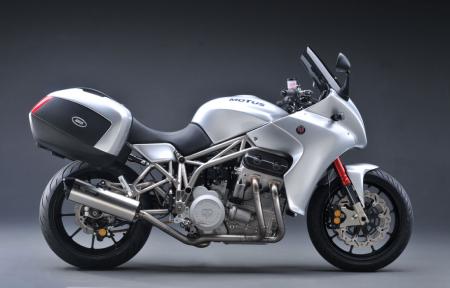 This side profile shot naturally draws comparisons to another motorcycle with a longitudinally mounted V-engine: the Moto-Guzzi Norge. This side profile shot naturally draws comparisons to another motorcycle with a longitudinally mounted V-engine: the Moto-Guzzi Norge. |
Speaking of handling, the MST will come equipped with 43mm inverted forks that are fully adjustable. Fork supplier for the standard MST is yet to be determined, but the higher-spec MST-R model is expected to wear Ohlins suspension front and rear. The standard rear shock supplier is also yet to be finalized, but expect full adjustability.
Stopping power comes from dual 320mm floating rotors up front, clamped by four-piston, radially mounted calipers. As of press time, Hayes will provide the calipers for the standard model; expect Brembo units for the R model. A standard two-pot caliper handles rear braking duties. This is all transferred to the ground via Michelin Pilot Road 3 tires on 17x3.5-inch front, 17x6.0-inch rear wheels. All told, the MST is predicted to weight 500 pounds, dry—about on-par with similar sport-touring rigs.
The Future Ahead
The MST looks like it has the ingredients to challenge for top sport-touring honors against some of the most respected names in the industry. From the onset, Conn and Case centered the design and execution of the MST around three premises: performance, comfort, and range. They wanted a motorcycle with sportbike-like performance that wouldn’t require chiropractic assistance afterwards, and fuel economy that limits the number of gas stops. With the KMV4 engine, more upright ergos, and a six-gallon tank, they believe they’ve accomplished just that.
So who does the MST appeal to? “We think it will draw two types of riders,” Conn said, after admitting to being both types. There’s the sportbike rider who is getting older and can’t bend like a gymnast anymore, but still wants performance and range, and then there’s the cruiser rider who can relate to the V4 engine because “it looks like the one in my truck.”
After speaking with Conn at length, it’s clear he and Case have poured their heart and soul into this project, but the glaring question remains: Why now? Especially in these economic times?
“We don’t think there’s a better time,” Conn explained, with a clear sense of patriotism in his voice. “If [the American] people don’t get off their ass there won’t be any manufacturing left in this country.”
We are witnessing the opening chapters in the Motus story. There are still long roads ahead, especially since a true production version is yet to be made. Numerous testing miles need to be logged to make sure all the components meet certain standards. At the conclusion of the weekend’s racing and festivities in Daytona, Conn and Case are personally going to ride the two existing prototypes across the country, meeting with potential dealers, media and the public, to put the bikes to the test. They’ll be followed the entire way by a team of engineers from Pratt & Miller to chart the progress and remedy any possible mishaps.
“The plan is to ride them until they break, fix it, and ride it ‘till they break again. By that point, they’ll stop breaking.”
Tentatively speaking, the MST and MST-R are slated for production in late 2011 as 2012 models, but certain things like securing suppliers and, more importantly, passing quality control tests, can push back that date.
“We only have one chance to get this right. We’re not going to cut corners and screw it up. If that means delaying production, so be it.”
Pricing is yet to be determined, but as it’s a niche bike built in small volumes, expect a price tag that reflects that. Then again, volume will depend on the number of dealers interested, and that in turn could help lower costs.
One thing’s for sure: Lee Conn and Brian Case are determined to turn Motus into another example of the American dream.
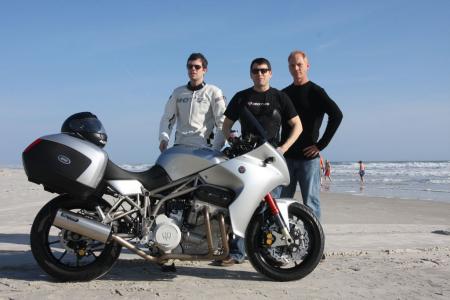 Brian Case (left) and Lee Conn (center) with 1993 World Superbike Champion, Scott “Mr. Daytona” Russell. The Motus MST stands in the foreground. Brian Case (left) and Lee Conn (center) with 1993 World Superbike Champion, Scott “Mr. Daytona” Russell. The Motus MST stands in the foreground. |
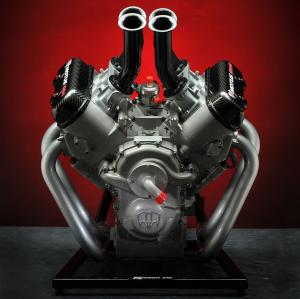 While the KMV4 engine in the MST is an original design, it’s heavily derived from the LS7 V8 engine. The same one used in the Chevrolet Corvette, minus half the cylinders.
While the KMV4 engine in the MST is an original design, it’s heavily derived from the LS7 V8 engine. The same one used in the Chevrolet Corvette, minus half the cylinders.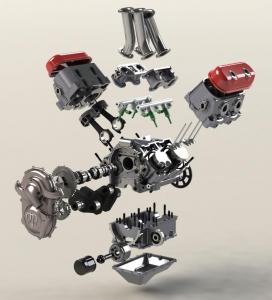 Deconstructed, you can see much of the same architecture the makes up a small-block V8 has been incorporated in the KMV4.
Deconstructed, you can see much of the same architecture the makes up a small-block V8 has been incorporated in the KMV4. Pratt & Miller were tasked with chassis development, drawing on years of experience – and championships – on the auto-racing stage. Note the longitudinally-mounted engine tilted slightly forward for optimum weight distribution and handling.
Pratt & Miller were tasked with chassis development, drawing on years of experience – and championships – on the auto-racing stage. Note the longitudinally-mounted engine tilted slightly forward for optimum weight distribution and handling.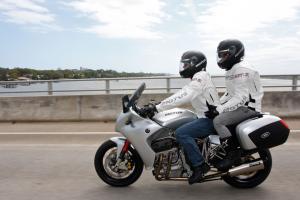 Two-up riding is an essential part of sport-touring, and the MST accommodates passengers nicely.
Two-up riding is an essential part of sport-touring, and the MST accommodates passengers nicely.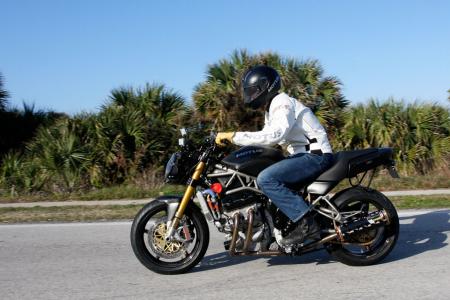 This MST-R (note the Ohlins fork and Brembo caliper) prototype is being ridden sans bodywork to make it easier to diagnose any potential concerns, either mechanically or electronically. We happen to like the way this looks. Motus MST Streetfighter, anyone?
This MST-R (note the Ohlins fork and Brembo caliper) prototype is being ridden sans bodywork to make it easier to diagnose any potential concerns, either mechanically or electronically. We happen to like the way this looks. Motus MST Streetfighter, anyone? Conn and Case will be followed on their cross-country journey by engineers from Pratt & Miller.
Conn and Case will be followed on their cross-country journey by engineers from Pratt & Miller.
No comments:
Post a Comment